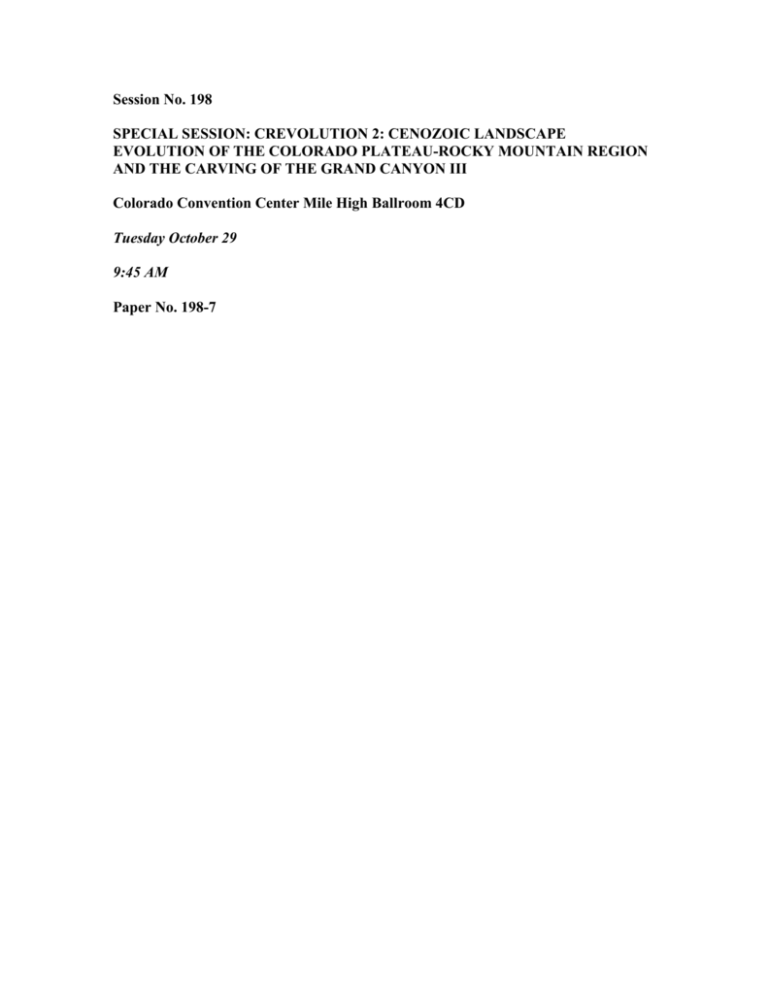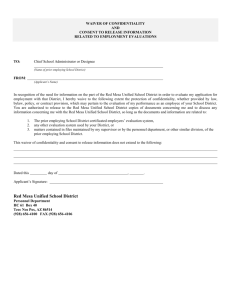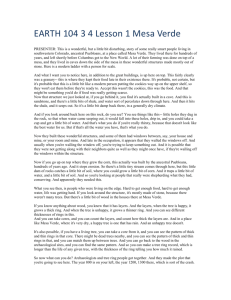PresentationNotes
advertisement

Session No. 198 SPECIAL SESSION: CREVOLUTION 2: CENOZOIC LANDSCAPE EVOLUTION OF THE COLORADO PLATEAU-ROCKY MOUNTAIN REGION AND THE CARVING OF THE GRAND CANYON III Colorado Convention Center Mile High Ballroom 4CD Tuesday October 29 9:45 AM Paper No. 198-7 1 Title Thank you in advance for listening, and thanks to Karl for inviting us to speak. Our purpose today is to present alternative explanations for several key aspects of the recently named and described Miocene Crooked Ridge paleoriver of northeast Arizona. 2 White Mesa Crooked Ridge Study Area near Eastern Grand Canyon The White Mesa-Crooked Ridge study area lies in northeast Arizona only 60 km east of the Grand Canyon. Understanding the late Miocene alluvial deposits in this area is important to ongoing studies of the age and origin of the Colorado River in Grand Canyon. Pre-canyon cutting depositional precursors of the Colorado River system east of the Kaibab Plateau are present in only two places—the White Mesa-Crooked Ridge area and the deposits of the Bidahochi Formation 120 km southeast of the study area. The northeast alignment of the White Mesa area emphasizes its geological significance. Indeed, a person standing on the northeast end of White Mesa looks southwest over a terrain that slopes terrace-like toward the Grand Canyon, which is visible in the distance. And, to the northeast, the alignment points 400 km directly towards the San Juan Mountains of southwest Colorado—which others believe is the source of the ancient river. Miocene alluvial deposits and lag surfaces in the study area contain metamorphic, igneous, and volcanic gravelstones derived from the San Juan Mountains volcanic field. The presence of these rocks in the Miocene alluvium argues for a San Juan Mountain origin of the Crooked Ridge paleoriver. Lucchitta and others recently made this argument in 2011. However, in this case, the devil is in the details. We will offer an alternative hypothesis that suggests a different age, depositional environment, and source area of the paleoriver. 3 Outcrops and Important Features Related to the White Mesa Alluvium Shown here is our topical geologic map of the study area and the location of three measured stratigraphic sections: one at Crooked Ridge and two on White Mesa. Although our analyzes are not yet complete, we think our data support the conclusions presented today. The study area extends northeast 64 km from The Gap to the north end of White Mesa. Depositional remnants of the White Mesa-Crooked Ridge paleochannel system are preserved along this 64-km reach on Crooked Ridge and on White Mesa. We refer to these deposits as the “White Mesa alluvium” for the characteristic and abundant outcrops on White Mesa. A narrow, sinuous gravel-capped ridge connects the Crooked Ridge and White Mesa outcrops. This is the “Crooked Ridge” of modern topographic maps. Wildcat Peak west of the Red Lake monocline is a monchiquite intrusive that was dated at 19 million years by Billingsley and others in 2008. We have found monchiquite clasts in the gravels of a tributary paleochannel that drained the Wildcat Peak area. White Mesa is the remnant of a paleovalley system incised through the Cretaceous Dakota Sandstone and into the underlying Jurassic Entrada Sandstone. The topography of White Mesa is inverted, rising about a kilometer above the present baselevel of the Colorado River. 4 Alternative Explanation of the Crooked Ridge The results of our studies suggest alternative explanations for several key aspects of the Crooked Ridge paleoriver. We believe that the age, stratigraphic correlation, depositional environment, geomorphology, tectonics, and origin of the paleoriver all have viable explanations that differ from those proposed earlier. Specifically: The paleoriver and related deposits are probably late Miocene. Alluvial deposits are likely correlative with all or part of the Bidahochi Formation. The depositional environment was probably a suspended load channel system. Five paleochannels are present. The steep gradient of the paleochannel is related in part to isostatic rebound as recently discussed by Lazear and others in 2013. Exotic gravelstones of San Juan Mountain origin in the alluvium were most likely reworked into the late Miocene Crooked Ridge paleochannel system. And finally, the paleoriver probably did not originate in the San Juan Mountains. 5 White Mesa Geology As shown on this map, the White Mesa alluvium is relatively widespread on White Mesa and ranges in thickness from 23to 50 meters. The mesa is capped by the Dakota Sandstone, and most of the alluvium was deposited on and eventually overtopped the underlying Entrada Sandstone Five paleochannels, shown with pink arrows, converge on southern White Mesa, forming the White Mesa paleovalley, which is 5 to 6 km wide. And, inselbergs, shown with pink plus signs, mark the former course of paleochannels where deposits are not present due to subsequent to erosion. Gravel clasts in the channels are largely Cretaceous sandstone; however the lithologic composition of the clasts differs in detail among the channels suggesting at least two different source terrains. The White Mesa tuff crops out on the northeast end of White Mesa. The expected age of the tuff is 14 million years, based on lithologic similarity with a 13.7 million year tuff in the Bidahochi Formation dated by Dallege and Ort in 1999. The tuff is presently undergoing chronometric analysis. We think that the age of the White Mesa alluvium, based on inclusion of detrital zircon, is younger than 20 to 18 million years. And, geomorphic relations indicate that it pre-dates regional canyon cutting at 6 to 5 million years. Geologic relations suggest that is equivalent to all or part of the 16 to 6-million year old Bidahochi formation. 6 Correlation The take away message from this correlation chart is that the interbedded veryfine-grained sand unit, shown in gray, dominates the stratigraphy. This unit consists of multiple fining upward cycles with locally interbedded gravels. The unit was probably deposited in a relatively low energy suspended-sediment channel system. And, these deposits are widespread—they are the defining feature of the White Mesa alluvium. Gravels, shown in yellow, occur at the base, middle, and top of the section, they are submature, as we’ll describe later. The gravelstones are predominantly local bedrock with minor amounts of reworked exotic pebbles and cobbles. Detrital zircon sampled and analyzed by Karl Karlstrom and interpreted by Bill Dickinson and Karlstrom was sampled at Crooked Ridge and northern White Mesa. The Crooked Ridge sample has a suite of 35 to 23 million-year old zircons that comprise four percent of the sample. These ages are similar to the age of the San Juan Mountain volcanic field, as well as to several intrusive bodies west of the San Juan Mountains. It also contains zircons as young as 20 to 18 million years. We think the zircons were reworked into the White Mesa alluvium. Interestingly, the DZ sample from northern White Mesa does not contain the younger suite. The youngest suite in that sample is 90 million years, pointing to a Cretaceous-source terrain. 7 Basal Gravel at Crooked Ridge Working up through the stratigraphic section, let’s first describe the basal gravels. At Crooked Ridge, where the zircon sample was collected, the gravel has an immature appearance consisting mainly of subangular to subrounded sandstones in a coarse sand matrix. Rare metamorphic, igneous, and volcanic clasts of San Juan Mountains origin are also present. 8 Basal Gravel on Southern White Mesa Shown here is the well-exposed and semi-consolidated basal gravel present on southern White Mesa. This gravel, as well as most others in the alluvium, has a matrix supported fabric. Generally, and regardless of stratigraphic position, the gravels appear texturally immature, having abundant subangular to subrounded clasts. The lateral discontinuity and immature texture suggest the gravels were not deposited in a large and vigorous fluvial system. 9 Gravel Shape Shown in this photograph are samples of pebble to cobble-size igneous, metamorphic, and volcanic clasts showing the low sphericity typical of gravel in the White Mesa alluvium. Angular faces with rounded corners are common as well as a variety of odd, asymmetric shapes. We think these odd shapes and secondary roundings are evidence of reworking by the White Mesa depositional system. We infer that weathered, broken gravelstones entered the active channel system of the White Mesa alluvium in which they were only slightly modified during transport in this relatively short, low energy depositional setting. Unmodified and normally shaped clasts comprise the smaller proportion of the typical gravel. These clasts probably lay below the weathering profile in the source terrain. 10 Upper Units of White Mesa Alluvium at Crooked Ridge Taken at Crooked Ridge, this panoramic photograph illustrates the appearance of the upper units of the White Mesa alluvium. Exposed here are the interbedded clay and sand unit, the lateral accretion clay-sand unit, and the capping light-colored petrocalcic horizon. The lower clay and sand unit shows multiple beds of poorly sorted sand and clay with stratification extending continuously across the outcrop. The overlying lateral accretion unit consists of poorly sorted sand displaying lateral accretion surfaces, channel forms, and overbank fines. 11 Interbedded Clay and Sand Unit on Southern White Mesa This photograph shows an unusually nice exposure of the interbedded clay and sand unit in the White Mesa paleovalley of southern White Mesa. Of interest is the distinctive laterally continuous stratification that is highlighted by slight changes in color. This lateral continuity and the lack of channeling suggest that the unit aggraded on a relatively broad floodplain. 12 South Channel As previously mentioned, five paleochannels converge on southern White Mesa that together form the White Mesa paleovalley. The channel shown here is the narrowest of the five with a bedrock bounded width of 150 m. The alluvium, 50 meters thick, filled the bedrock channel, overtopped the Dakota Sandstone, and spilled into the paleovalley. This north flowing paleochannel contains clasts of monchiquite that were derived from the 19-million year old Wildcat Peak intrusive 11 km to the south. 13 Northeast White Mesa Channel Section Here, we see an oblique partial cross-section 400 meters in length through the paleochannel on northeast White Mesa. The valley margin is exposed on the upper left portion of the photograph, and the valley is about 100 m deep as measured from the top of the Dakota Sandstone. Channel margins typically have locally derived sandstone-block alignments that are several tens of meters in length. 14 Gradient of the Paleochannel Understanding the gradient of the paleochannel system is necessary to project the system upstream or downstream of the study area. Illustrated here is the present slope and the isotatically-adjusted paleoslope of the White Mesa alluvium along with the control points used to estimate the gradient. Two of the control points are the fossiliferous limestones at Crooked Ridge and White Mesa. These define an approximately contemporaneous stratigraphic horizon near the base of the alluvium that helps constrain the slope estimates. The present slope is 7 per thousand, which is very steep for a large and long river system such as the San Juan. However, because of post-10 million year isostatic rebound related to regional denudation, the course of the paleochannel was uplifted about 200 m at its northeast terminus. After adjusting for this uplift, the pre-10 million-year paleoslope is estimated to be about 4 per thousand, which is still steeper than the expected gradient of a large and long river. 15 San Juan River Gradient As shown in this table, the paleochannel of the White Mesa alluvium is anonymously steep when compared to the analogous San Juan River. If we accept the present slope of 7 per thousand, the paleochannel is four to seven times steeper than the San Juan River where it flows on rocks similar to those underlying the White Mesa alluvium. As previously noted, the isostaticaly adjusted paleoslope is 4 per thousand, which is still two to four times steeper than the San Juan River, even though the river gradients were measured 90 to 140 km upstream of White Mesa where the gradients are expected to be steeper. 16 Paleotopography and Headwaters of the White Mesa Paleochannel System In closing, this map portrays our alternative and preliminary course of the White Mesa paleovalley system. As we see it, the headwaters of this ancient fluvial system was in or near the socalled “San Juan Mountains volcanic field piedmont” that was described by Cather and others in 2003 and 2008. This piedmont drainage system is thought to have extended 200 kilometers southwest of the volcanic field. Erosion of the deposits underlying this surface, or their remnants, provided the reworked gravelstones present in the White Mesa alluvium. The paleochannel coursed southwest from the source area along the southern end of the Monument upwarp eventually aligning with the Organ Rock monocline. From there it extended down the homoclinal southwest dip of the Shonto Plateau to White Mesa where it was joined by two tributaries from the north and northeast and one from the south. Continuing southwest to and through The Gap, the paleochannel turned south to perhaps join an ancestral Little Colorado River or even a northwestern extension of Hopi paleolake.







